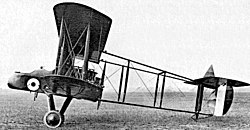RAF Anwick: Difference between revisions
adding coord to title in line with other RAF base articles |
m Disambiguate Lincoln to Lincoln, England using popups |
||
| Line 31: | Line 31: | ||
}} |
}} |
||
{{Coord|53|02|51.87|N|00|20|59.63|W|display=title|format=dms}} |
{{Coord|53|02|51.87|N|00|20|59.63|W|display=title|format=dms}} |
||
'''RAF Anwick''' was a World War II [[faux]] Royal Air Force station near the village of [[Anwick]], 21.3 miles (34.2 kilometres) south east of the county town of [[Lincoln]] , [[Lincolnshire]], England. The airfield was located in a field three quarters of a mile north-north-west of Anwick village. |
'''RAF Anwick''' was a World War II [[faux]] Royal Air Force station near the village of [[Anwick]], 21.3 miles (34.2 kilometres) south east of the county town of [[Lincoln, England|Lincoln]] , [[Lincolnshire]], England. The airfield was located in a field three quarters of a mile north-north-west of Anwick village. |
||
Originally constructed and operated as a [[Royal Flying Corps]] aerodrome in September 1916 it closed between the wars, reopening in September 1939 as a Royal Air Force decoy site to divert bombing raids away from nearby [[RAF Digby]], the closest active fighter airfield. |
Originally constructed and operated as a [[Royal Flying Corps]] aerodrome in September 1916 it closed between the wars, reopening in September 1939 as a Royal Air Force decoy site to divert bombing raids away from nearby [[RAF Digby]], the closest active fighter airfield. |
||
Revision as of 16:06, 2 February 2011
 An FE.2b aircraft which was one of the first types to be flown from Anwick | |||||||||||
| Summary | |||||||||||
| Airport type | Military airfield. Decommissioned and abandoned in August 1942 Airfield active only during World War I. During World War II acted as a decoy site for RAF Digby | ||||||||||
| Operator | Royal Flying Corps Royal Air Force | ||||||||||
| Standort | Anwick, Lincolnshire | ||||||||||
| Elevation AMSL | 200 ft / 60.96 m | ||||||||||
| Coordinates | 53°02′51.87″N 00°20′59.63″W / 53.0477417°N 0.3498972°W | ||||||||||
| Runways | |||||||||||
| |||||||||||
Airfield code was ‘’’X0AN’’’ | |||||||||||
53°02′51.87″N 00°20′59.63″W / 53.0477417°N 0.3498972°W RAF Anwick was a World War II faux Royal Air Force station near the village of Anwick, 21.3 miles (34.2 kilometres) south east of the county town of Lincoln , Lincolnshire, England. The airfield was located in a field three quarters of a mile north-north-west of Anwick village.
Originally constructed and operated as a Royal Flying Corps aerodrome in September 1916 it closed between the wars, reopening in September 1939 as a Royal Air Force decoy site to divert bombing raids away from nearby RAF Digby, the closest active fighter airfield.
A minimal facility, even at the height of its active use, the airfield had only grass runways and no permanent brick buildings or hangars. All accommodation was of wooden and metal temporary construction. Within a few years of closing in 1942 there were no visible remains of the former flying facility, although a private landing strip and hangar now exist not far from the original aerodrome.
History
The airfield opened in November 1916 as a Royal Flying Corps aerodrome with three grassed runways laid out in an equilateral triangle. The aerodrome remained busy throughout World War I as a flying training establishment with a large number of aircraft present, flying mostly a motley assortment of de Havilland DH and Royal Aircraft Factory BE and FE marques.
The station was mothballed and placed on a care and maintenance basis between the wars. Surveyed in 1937 as a possible fighter base it was decided that the terrain and location was unsuitable for tarmac runways. Instead the grass runways were retained and the station was earmarked as a future decoy airfield, a role that started in September 1939.
The airfield was manned by shifts of eight airmen responsible for lighting flare lamps with a portable generator at night that simulated a runway in use, with the intention of drawing the attention of any German bombers looking to attack an airfield. More accurate electronic navigation aids during the later phases of the war rendered these efforts less useful and the practice was abandoned by 1942.
RAF Anwick was abandoned and dismantled in August 1942.
Timeline and units of RAF Anwick
| Date | Event or Unit | Notes |
| September 1916 | Opened as Royal Flying Corps Aerodrome Anwick | |
| September 1916 | No. 38 Squadron RFC | Flying FE. 2b aircraft. Arrived from RAFC Castle Bromwich commanded by Arthur Harris who would later become Air Chief Marshall Harris and commander of Bomber Command in World War II. The squadron redeployed to Dunkirk in May 1918. |
| September 1916 | No. 33 Squadron RFC | Flying Royal Aircraft Factory BE.2s and later Royal Aircraft Factory FE.2s the squadron was employed in the Home Defence role, guarding against German airship raids against northern England. The squadron also operated from Scampton, Kirton in Lindsey and Elsham Woods aerodromes. |
| October 1917 | No. 90 Squadron RFC | Renamed No. 90 Squadron RAF in April 1918 the squadron never saw active combat and was disbanded in August 1918. |
| April 1918 | The station is renamed RAF Anwick | |
| June 1919 | RAF Anwick closed and placed on a care and maintenance basis | |
| September 1939 | RAF Anwick reopens as a decoy airfield for RAF Digby | |
| August 1942 | RAF Anwick closed and dismantled |
The airfield today
No sign of the airfield remains today but there is a private landing strip and hanger at Anwick that are assumed to be sited close to or on the original aerodrome location. There is a small memorial plaque acknowledging the airfields existence on the main road in Anwick.
See also
References
Main reference
- Bruce Barrymore Halpenny Action Stations: Wartime Military Airfields of Lincolnshire and the East Midlands v. 2 (ISBN 978-0850594843)
